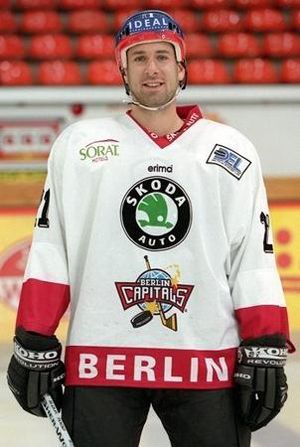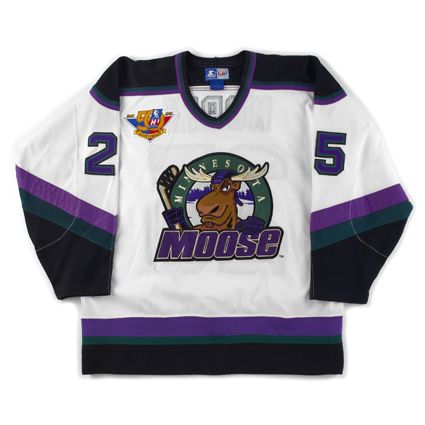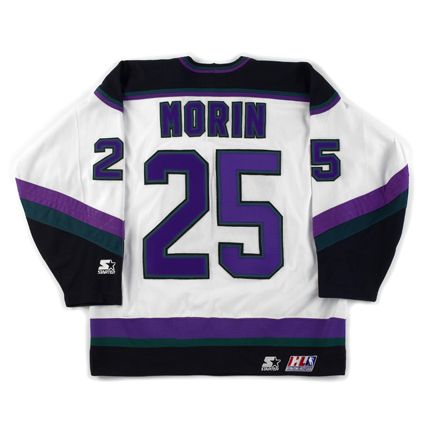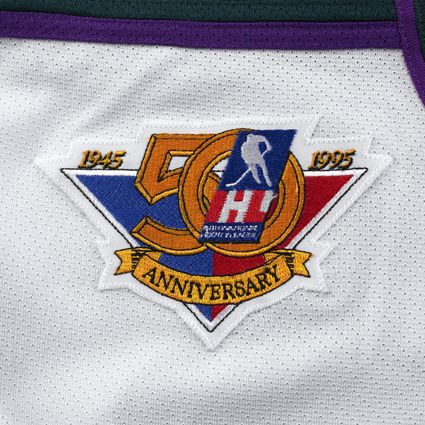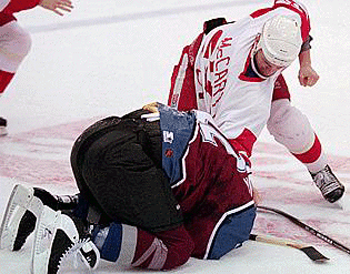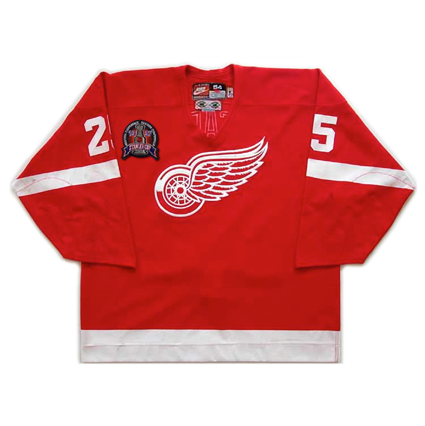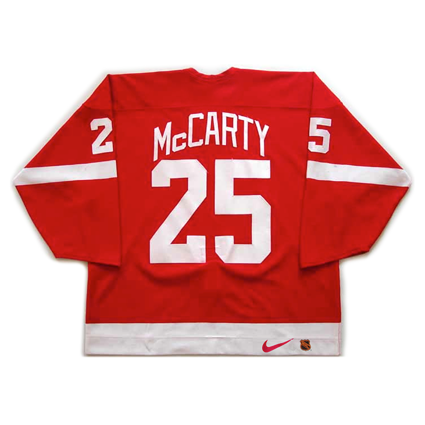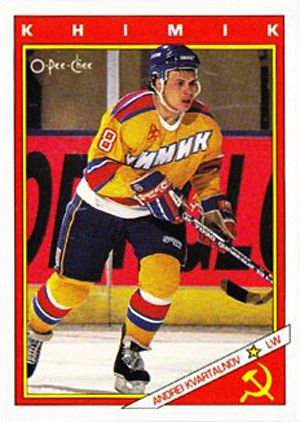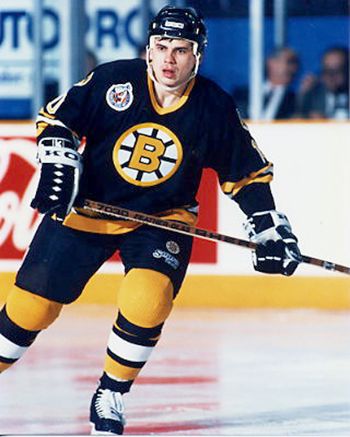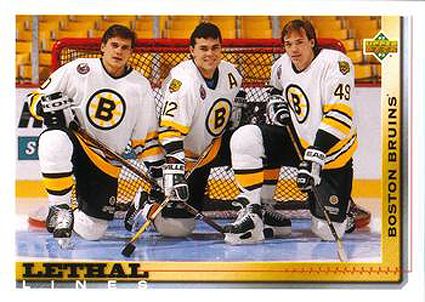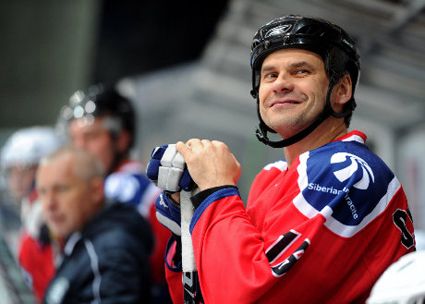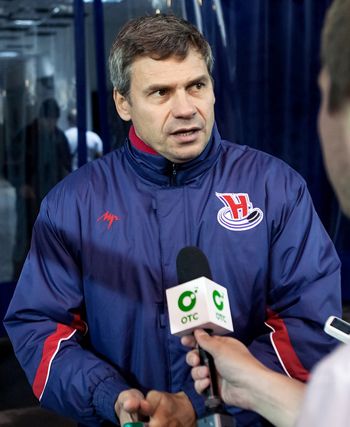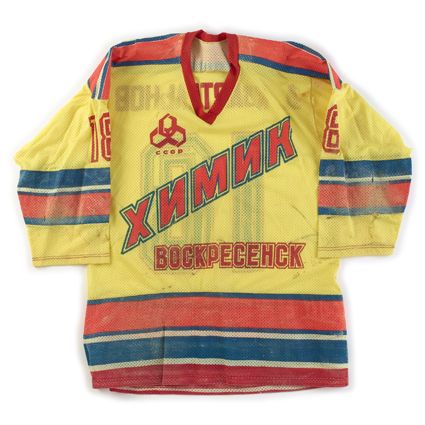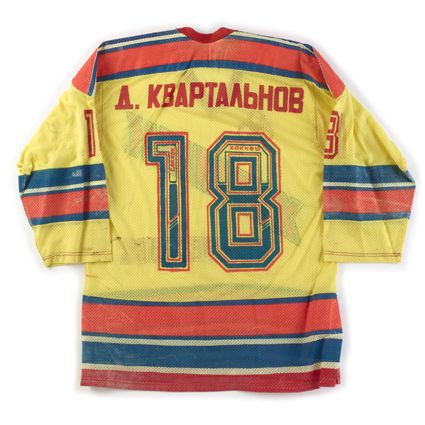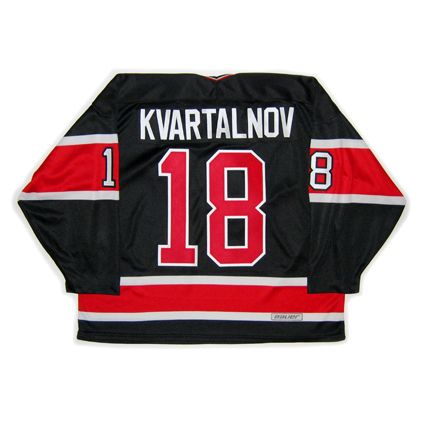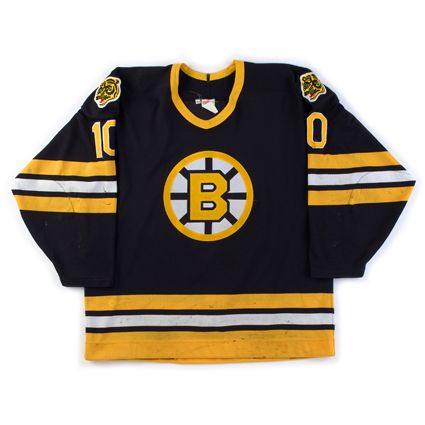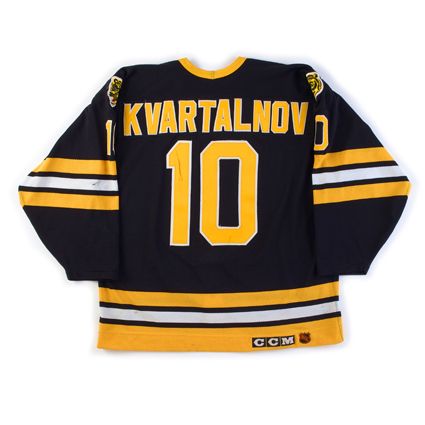Saturday, March 27, 2010
1994-95 Minnesota Moose Stephane Morin Jersey
Born on this date in 1969, Stéphane Morin played junior hockey for the Shawinigan Cataractes and then the Chicoutimi Sagueneens. After splitting the 1987-88 season between the two clubs, Morin would get himself noticed with 77 goals and 109 assists for 186 points in just 77 games in 1988-89, which led to him being drafted 43rd overall in the 1989 NHL Entry Draft by the Quebec Nordiques.
He would spend the majority of the 1989-90 season with the Halifax Citadels of the American Hockey League, but would make his NHL debut with six games with the Nordiques, in which he would register his first NHL points with a pair of assists.
While he would split the next two seasons between Quebec and Halifax, he would see action in 48 NHL games, which included scoring his first NHL goal, in 1990-91, a season in which he would place fourth in scoring for the Nordiques with 13 goals and 40 points despite only competing in a total of just 48 games.
The 1991-92 season with Quebec as a disappointment, with just two goals and eight assists for ten points in 30 games.
Released by the Nordiques organization, Morin signed with the Vancouver Canucks in 1992. Assigned to the Hamilton Canucks of the AHL, Morin led the team in scoring with 31 goals and 85 points in 70 games. He did play a game in Vancouver, registering an assist, in his only NHL appearance that season.
The following season was very productive offensively for Morin, as he again led Hamilton in scoring with 109 points in 69 games, good for fourth overall in the AHL that season. He would also contribute a goal and an assist in five games with Vancouver.
With his time in Vancouver at an end, Morin signed on with the brand new Minnesota Moose of the International Hockey League, who came into being to fill some of the void left by the departure of the Minnesota North Stars. Morin not only led the Moose in scoring, but the entire IHL in 1994-95 with 33 goals and 81 assists for 114 points in 81 games.
His point total would decline the following season to 78, but he would still lead the Moose in scoring.
1996-97 saw Morin and the team move to Manitoba, but he would find himself moving to the Long Beach Ice Dogs, still in the IHL, after only 12 games in Winnipeg. Long Beach was a strong team that season, winning the South Division and making it all the way to the IHL Turner Cup Finals. Morin, making the first real playoff run of his professional career, responded with 19 points in 18 games.
Morin's next season with Long Beach was limited to just 27 games in which he scored 27 points. Another playoff run for Long Beach would see them win a pair of rounds before falling in the semifinals, but not before Morin would contribute 11 points in 13 games.
For the 1998-99 season, Morin relocated to Europe, signing with the Berlin Capitals of the DEL.
Off to a good start in Germany, Morin scored a pair of goals plus six assists for eight points in his first handful of games, but then shockingly and tragically, after complaining of not feeling well during the first period of the seventh game of the season, Morin died of a heart attack at the age of 29 on October 6, 1998 after he collapsed at the bench early in the second period leaving behind a wife and newborn son.
Today's featured jersey is a 1994-95 Minnesota Moose Stéphane Morin jersey from the season Morin led the Moose and the IHL in scoring.
The Moose would only play two seasons in Minnesota and Morin would hold the team records for most assists and points in a season, as well as career goals, assists and points, as well as games played.
While the three color combination of the forest green trim and purple outline against the black was a questionable choice at best, as the separation of the green from the purple and black is nearly impossible to make out for even the larger numbers and really becomes a dark mass when reduced in size for the name on the back.
While the back of the jersey has it's flaws, the front of the jersey is a winner, with the IHL 50th Anniversary patch providing a shot of color and the very popular Moose logo, which was ranked #1 in a poll by The Hockey News and led all minor league teams in terms of merchandise sales, making for a very attractive jersey.
Today's videos begin with some game action of the Moose from the 1994-95 season.
But what would minor league hockey be without the fights? Here is some rare footage of the Moose playing at the St. Paul Civic center with solid white dasherboards after having replaced the original clear boards due to their age and the advent of dasherboard advertising rendering them ineffective.
For comparison, here's some footage from the St. Paul Civic Center in 1984 with the original set of clear boards.
Labels:
IHL,
Minnesota Moose,
Morin Stephane
Friday, March 26, 2010
1996-97 Detroit Red Wings Darren McCarty Jersey
On May 29th during Game 6 of the Western Conference Finals of the 1996 NHL playoffs, Claude Lemieux of the Colorado Avalanche checked Kris Draper of the Detroit Red Wings from behind face first into the top edge of the boards in front of the Red Wings bench. Draper suffered horrible injuries, which included a broken jaw, broken nose, shattered cheekbone, numerous stitches and a concussion. The Avalanche would go on to defeat the Red Wings and eventually win the Stanley Cup. At the conclusion of the series with Detroit, the Red Wings Dino Ciccarelli said about Lemieux, "I can't believe I shook the guy's freaking hand."
During the 2006-07 season, Colorado and Detroit would meet three times without incident, but Lemeiux was not in the Colorado line up for any of those contests. It was on this date in 1997 that the teams would meet once again, but the stakes were now very different.
At this late date in the season, each club was in position make the playoffs, setting up a possible playoff matchup down the road. In addition, Lemeiux was now going to be in the Colorado lineup, facing off against the Red Wings for the first time in ten months since the savage incident with Draper.
The first fight of the evening occurred at the 4:45 mark of the first period, with another at 10:14. Things really exploded at 18:22, still in the first, as a scuffle between the Red Wings Igor Larionov and Colorado's Peter Forsberg gave the Red Wings Darren McCarty the opportunity he had been waiting for.
Breaking away from an official, McCarty surprised Lemeiux and blasted him in the temple with his glove still on, sending Lemeiux, dazed, down in a heap. McCarty then tore of Lemieux's helmet and began to rain haymakers down on Lemeiux. Unable to defend himself after the sucker punch he had received, all Lemieux could do at that point was cover his head and wait out the assault, which continued unabated as McCarty punched him repeatedly. As one official tried to restrain McCarty, he would even knee Lemeiux in the head along the boards in retribution for his hit on his friend and teammate Draper.
The dazed Lemieux was in no shape to defend himself following the initial blow to the head and did not fight back. To this day he is considered by many to have cowardly "turtled".
At the same time as this was happening, Patrick Roy would come flying out from the Avalanche goal to aid Lemeiux, only to be intercepted by Brendan Shanahan. Roy's arrival on the scene would only serve as an invitation to Mike Vernon to join the battle and eventually the two netminders would square off in one of the classic goalie fights of all time, leaving Roy bloodied as both fighters landed some solid blows.
"As soon as he [Roy] started, I started, " said Vernon. "And then he and Shanny collided. Patrick and Foote were both on Shanahan. The first guy I grabbed at was Foote, which was really a stupid thing to do. Then Patrick kind of jumped me from behind."
"Fight Night at the Joe" would continue just 15 seconds after the puck was dropped when Adam Deadmarsh went after the rugged Vladimir Konstantinov.
The period break had no calming effect, as just four seconds into the second period Adam Foote and Shanahan tried to rearrange each other's dental work. The period continued in a similar fashion when Mike Keane pummeled Thomas Holmstrom and a topless Brent Severyn was held off by Aaron Ward at just 3:34.
Amazingly, McCarty remained in the game following his assault on Lemeiux, having only received a double minor for roughing! Deadmarsh sought retribution for Lemeiux and he and McCarty had a brawl at 7:24. Jamie Pushor and Uwe Krupp then exchanged blows at 11:26.
Meanwhile the score of the game stood at 3-2 in favor of Colorado. Each team would score another goal before the end of the second to make game 4-3 in favor of the Avalanche after two, with six goals having been scored amongst all the fights in the second period.
Things settled down for the most part after the Pushor/Krupp fight, with only a pair of roughing penalties in the third period as Colorado scored to increase their lead to a pair of goals at 1:11, only to have Detroit excite the home fans with goals at 8:27 and 9:03 to tie the contest, which would go to overtime, won by McCarty of all people, 39 seconds into the extra period to give Detroit not only their revenge on Lemeiux, but a 6-5 win over their hated rivals, their first victory over Colorado all season.
"They should have had a few different calls," said Colorado coach Marc Crawford. "The ref told me before the second period that he blew it. That's a small consolation. The linsemen even said it should've been a gross misconduct on McCarty. It's a little ironic that he got the overtime goal."
The game ended with 18 fighting majors and 144 penalty minutes being called. Combatant Vernon got the win in goal for Detroit, the 300th victory of his career.
Asked if he looked forward to a playoff matchup with Detroit, Keane responded , "I've got no problem playing a heartless team. Absolutely, I'd like to play them. We don't like each other. It will make a great series."
The two teams would meet in the Western Conference Finals that season, with Detroit eliminating the defending champion Avalanche in six games, eventually capturing the Stanley Cup with a sweep of the Philadelphia Flyers, a championship whose luster would be tarnished by the limousine crash that would leave Konstantinov in a coma for weeks and ending his career.
For further reading on the intense rivalry between the Detroit Red Wings and the Colorado Avalanche, we suggest "Blood Feud: The Inside Story of Pro Sports' Nastiest and Best Rivaly of It's Era".
Today's featured jersey is a Nike 1996-97 Detroit Red Wings Darren McCarty jersey. This jersey features the Stanley Cup Finals patch worn by the Red Wings and Flyers during all games of the Stanley Cup Finals.
McCarty scored a highlight reel goal for Detroit that put the Red Wings up 2-0 and became the game winner when the Flyers scored an otherwise meaningless goal with 15 seconds left in the game.
Here is part one of the fighting from Bloody Wednesday, which includes McCarty's sucker punch on Lemieux and the fight between Roy and Vernon.
Next is part two of "The Brawl in Hockeytown."
We hope you have some time on your hands today, as McCarty and Lemieux meet up for the first time ever to discuss the incident and what led up to it, thirteen years after the incident. It's a fascinating insight into "The Code" among hockey players and the mindset of both McCarty and Lemieux both then and now and the respect they have for each other. It's quite possibly the most interesting interview we've ever posted on Third String Goalie.
Labels:
Detroit Red Wings,
McCarty Darren
Thursday, March 25, 2010
1989-90 Khimik Voskresenek Dimitri Kvartalnov Jersey
Born on this date in 1966, Dimitri Kvartalnov looked for all the world to be on his way to NHL stardom.
Kvartalnov then moved to North America and joined the San Diego Gulls of the International Hockey League, where he destroyed the league, scoring 60 goals and 58 assists for 118 points in 77 games. Kvartalnov picked up a trio of awards that season as the Rookie of the Year, Scoring Champion and Most Valuable Player.
Kvartalnov began his career with five full seasons with Khimik Voskresenek of the Soviet League, which included leading the league in scoring in 1989-90 and playing for the Soviet Union in the World Championships twice, winning gold in 1989 and bronze in 1991.
Dimitri, incorrectly identified as his brother Andrei
Kvartalnov then moved to North America and joined the San Diego Gulls of the International Hockey League, where he destroyed the league, scoring 60 goals and 58 assists for 118 points in 77 games. Kvartalnov picked up a trio of awards that season as the Rookie of the Year, Scoring Champion and Most Valuable Player.
IHL scoring champion Kvartalnov
Following his stellar IHL season, the Boston Bruins selected Kvartalnov with the 16th pick in the 1992 NHL Entry Draft.
Already with ten years of pro experience and entering the prime of his career at age 26, his NHL career got off to a record start in 1992 with 12 goals and ten assists to give him points in his first 14 games, a mark that would stand for fifteen years until surpassed by Evgeni Malkin in 2007.
Playing on "The Bonanza Line" of Adam Oates (Adam) and fellow NHL rookie Joe Juneau (Little Joe) and Kvartalnov (Hoss), the line would score nearly a third of the Bruins goals that season, with 107 of the club's 332 for the year. Oates would finish third in league scoring with 142 points and Juneau topped 100 with 102 while setting a record for left wingers with 70. Kvartalnov would amass 30 goals and 42 assists for 72 points in 73 games in his first season and had the look of a future NHL star - at least on the outside.
The first sign of trouble was when the Bruins left him unprotected in the expansion draft, and despite his 30 goal season seemingly indicating enormous potential, he went unclaimed.
Once the season began, Kvartalnov found himself in coach Brian Sutter's doghouse. Sutter, who had little use for Kvartalnov's apparent one dimensional style of play, left him out of the lineup on many occasions during his second season. After 39 games, in which he scored just 19 points, half the pace of a year before, and with a -9 rating, Kvartalnov was placed on waivers and eventually demoted to Providence of the AHL. There he was back to a point a game, but his time with the Bruins and North America was over at the conclusion of the season.
Once the season began, Kvartalnov found himself in coach Brian Sutter's doghouse. Sutter, who had little use for Kvartalnov's apparent one dimensional style of play, left him out of the lineup on many occasions during his second season. After 39 games, in which he scored just 19 points, half the pace of a year before, and with a -9 rating, Kvartalnov was placed on waivers and eventually demoted to Providence of the AHL. There he was back to a point a game, but his time with the Bruins and North America was over at the conclusion of the season.
His career was far from over however.
Kvartalnov would move to Switzerland and play three seasons with HC Ambri-Piotta, finishing third in league scoring in 1995-96 and leading the team in scoring in 1996-97.
Klagenfurt AC in Austria was his next stop, where he would play for three seasons which included leading the team in scoring with 72 points in 45 games in 1997-98.
He would split the 1999-00 season between the Manheim Eagles in Germany and Jokerit Helsinki in Finland.
The following season he would return to Russia, joining Ak Bars Kazan where he would play for four seasons and lead them in scoring twice. 2004-05 saw a move to Cherepovets Severstal and then a return to Khimik for six games. He would play the 2005-06 season with Krylja Sovetov (Soviet Wings) in the lower division, helping them regain a place in the top league for 2006-07. Half way through the season Kryla would deal Kvartalnov back to Cherepovets, and he would retire at the conclusion of the season after a 24 year professional career in which he would score a total of 509 goals and 474 assists for 983 points.
Kvartalnov has subsequently gone into coaching and is currently the head coach of Sibir Novosibirsk of the KHL.
Kvartalnov has subsequently gone into coaching and is currently the head coach of Sibir Novosibirsk of the KHL.
Today's featured jersey is a 1989-90 Khimik Voskresenek Dimitri Kvartalnov jersey as worn by Kvartalnov when he was the leading scorer in the Soviet League. It's typical of the Soviet jerseys of the era in that it is a relatively light weight mesh and all the elements are either dye sublimated or screened on. Of note are the wild numbers on the back, reminding us of the 1982 movie "TRON". This jersey also has Dimitri's first initial "D" on the back in cyrillic, as his brother Andrei was also a member of the team.
We obtained this jersey from a member of the Khimik traveling party during a game at Met Center in Bloomington, Minnesota when Khimik was playing a game in the Super Series against the Minnesota North Stars. Having no real idea who the players on the club were at the time, given our choice of a few different jerseys, we opted for the one with the longest name simply because it looked the most "Soviet". Only later when we decoded the Cyrillic lettering did we realize we had unknowingly obtained the jersey from the Soviet League's leading scorer from the year prior!
Bonus jersey: Today's bonus jersey is a 1991-92 San Diego Gulls Dimitri Kvartalnov jersey. version of the Gulls played in the IHL from 1990-91 to 1994-95 before moving north to become the Los Angeles Ice Dogs for one season prior to becoming the Long Beach Ice Dogs.
The Gulls wore the same striking black and red jerseys for their entire run in San Diego and are easily our favorites of any of the four teams to have used the San Diego Gulls name.
Extra bonus jersey: Today's extra bonus jersey is a 1993-94 Boston Bruins Dimitry Kvartalnov jersey. As well as obtaining Kvartalnov's game worn Khimik jersey, we later acquired his Bruins road jersey from his second season in the NHL. When paired with our Khimik jersey from the Soviet League, we like to call it our "Ultimate Home and Away Jerseys".
The Gulls wore the same striking black and red jerseys for their entire run in San Diego and are easily our favorites of any of the four teams to have used the San Diego Gulls name.
Extra bonus jersey: Today's extra bonus jersey is a 1993-94 Boston Bruins Dimitry Kvartalnov jersey. As well as obtaining Kvartalnov's game worn Khimik jersey, we later acquired his Bruins road jersey from his second season in the NHL. When paired with our Khimik jersey from the Soviet League, we like to call it our "Ultimate Home and Away Jerseys".
As you can imagine, the internet is not exactly overflowing with Kvartalnov videos, so we present you with the theme song to the TV series Bonanza, from where the Bruins Bonanza Line of Oates, Juneau and Kvartalnov got their name.
Wednesday, March 24, 2010
1980-81 University of Minnesota Neal Broten Jersey
Back in 1979, the NCAA tournament consisted of a mere five teams and the final games were played at the Olympia Stadium in Detroit, Michigan.
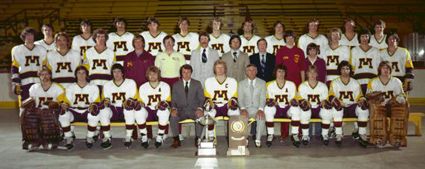

The single elimination tournament began with a single quarterfinal game on March 18th at Mariucci Arena in Minneapolis, pitting the University of Minnesota Golden Gophers, coached by the legendary Herb Brooks, against the Bowling Green State University Falcons and their star players George McPhee and Mark Wells, who were second and fourth in the nation in scoring that season. Minnesota had placed second overall in the Western Collegiate Hockey Association (WCHA) while Bowling Green had won the Central Collegiate Hockey Association (CCHA) by a wide 12 point margin in their 24 game schedule.
Minnesota came away with a 6-3 win, advancing to face the University of New Hampshire Wildcats in the first semi-final on March 22nd in Detroit. New Hampshire had placed second overall in the Eastern Collegiate Hockey Association (ECAC) and was led by Ralph Cox's 42 goals, which led the nation that season. Minnesota again triumphed by a 4-3 score to reach the National Championship Final.
In the other semifinal in Detroit on March 23rd, the Dartmouth College Big Green, fourth in the ECAC, was paired against the University of North Dakota Fighting Sioux, the WCHA regular season champions, who were led by Mark Taylor and Kevin Maxwell who tied for fourth and sixth in the national scoring race. The Fighting Sioux dispatched Dartmouth 4-2, making for an all-WCHA finale.
The championship final, held on this date in 1979, saw North Dakota and Minnesota come into the final game having split their four previous meetings earlier that season 2 games apiece. Minnesota was leading the contest 3-2 when Neal Broten scored a goal for the ages. Broten came up the left side of the ice, crossed the blueline into the North Dakota zone and made a cut toward the middle of the ice. As he did, the puck went to the right of the North Dakota defender facing him and Broten went around him to his left.
Having avoided that defender, Broten had also lost control of the puck, which was now several feet in front of him. At the same time, Broten was hit in the back by a backchecking Fighting Sioux player. The combination of the hit and that player's stick in front of him, as well as simply an effort to reach the escaping puck propelled Broten forwards and down onto the ice.
As he swung at the puck with his arms fully extended, he made contact with the puck in a position not unlike a curler sending a stone down the sheet, with his left leg folded under him and his right fully extended behind him. While this was happening, the goaltender for North Dakota was coming out to attempt cut down on the angle and began falling to the ice sideways in an effort to block the puck.
Broten, now having finished falling all the way to the ice on his side, began to roll onto his back as his chip shot took flight and cleared the goaltender, landing in the net for a 4-2 Gopher lead.
North Dakota would later score another goal to pull within 4-3, but the lead would stand and Minnesota would win the national championship on Broten's miraculous goal, which had now become the game winning goal, a moment now memorialized with a banner that hangs in the Gophers new Mariucci Arena.
The championship was the third for Minnesota under the guidance of Brooks, having previously won titles in 1974 and 1976. The roster for Minnesota that season was led by the team's leading scorer Steve Christoff, fourth in the nation in goals with 38 and ninth in points with 77, and Don Micheletti, who had 36 goals for fifth in the nation and was second on the team with 72 points. The rugged Micheletti's 112 penalty minutes also ranked third in the nation. Goaltender Steve Janaszak was named as the Most Outstanding Player in the NCAA Tournament.

For the Gophers, coach Brooks, Broten, Christoff, Janaszak, Bill Baker, Rob McClanahan, Mike Ramsey, Eric Strobel and Phil Verchota would go on to form the nucleus of the 1980 United States Olympic Team, which would defeat the Soviet Union 11 months later in the "Miracle on Ice" in Lake Placid, New York before capturing the gold medal against Finland.
Today's featured jersey is a 1980-81 University of Minnesota Neal Broten jersey. Broten wore #14 as a freshman with Minnesota in 1978-79 when he scored the game winning goal in the national championship game. On his return to Minnesota, following the year spent with the United States Olympic team in 1979-80, Broten reclaimed the number 7 that he wore in high school while playing in his home town of Roseau, Minnesota.
Oddly, now playing with his brother Aaron on the roster, instead of going with the expected and customary "N. Broten" to differentiate the brothers, they both wore their full names on the back of their jerseys despite their first names starting with different letters.

Neal Broten would be named the first winner of the Hobey Baker Award at the conclusion of the season in which he wore today's featured jersey.
If you would like to purchase one of these jerseys for yourself, or any of a number of other throwback Minnesota Golden Gophers jerseys, they are available from our friends at VintageMinnesotaHockey.com.
Today's video highlight shows history repeating itself, as Blake Wheeler, now of the Boston Bruins, would duplicate Broten's diving, game winning goal against the very same North Dakota Fighting Sioux, this one in overtime of the championship game of the WCHA Final Five in 2007.
Labels:
Broten Neal,
University of Minnesota,
WCHA
Tuesday, March 23, 2010
1945-46 Chicago Black Hawks Bill Mosienko Jersey
It was the final day of the 1951-52 season and the two worst teams in the NHL, both already eliminated from the playoffs, were playing just because they had to. Not even the officials seemed interested in the game, as they would fail to call a single penalty during the entire game. But the game was on the schedule and needed to be played, so on a rainy, windy night in Manhattan, just 3,254 fans felt it was worth their time to travel to Madison Square Garden on this day in 1952 to watch their New York Rangers play out the string against the last place Chicago Black Hawks.
They would be rewarded by seeing history made.
By the end of the second period the Rangers were up 5-2 and when New York's lead was extended to 6-2 early in the third period when Ed Slowinski completed a hat trick, the rout was on and some of the sparse crowd in attendance headed for the exits.
When Black Hawks center Gus Bodnar gathered up a loose puck at center ice and fed it to Bill Mosienko at the Ranger blueline no one was prepared for what happened next.
Mosienko headed for the goal and got around the off-balance Ranger defenseman Hy Buller and cut in on goaltender Lorne Anderson, faked to the left and shot low into the right side of the net for a goal at 6:09 of the third period. "It was my 29th goal of the season, so I went into the net to get the puck," Mosienko said.
With the score now still favoring the Rangers 6-3, the puck was dropped at center ice, Bodnar won the faceoff and spotted Mosienko again at the Ranger blueline and fired a pass. Mosienko took the pass and skated through the Ranger defense and fired the puck along the ice once more into the right side of the goal at 6:20, just 11 seconds after the first one.
"I'm sure Anderson was expecting high shots," recalled Mosienko. "Twice before during the game he had stopped high ones and I thought that he'd fall for the low shot. He did - a lucky thing for me."
The goal was Mosienko's 30th of the season, so he retrieved that puck from the net as well. "I guess some of the fans thought it was pretty funny when I got the puck. A bunch of them hooted and laughed."
Still, the Rangers were up 6-4 and it was time for another faceoff at center ice. The Black Hawks coach Ebbie Goodfellow motioned for Mosienko's line to stay on the ice and Bodnar once more captured possession of the puck. Bodnar passed it to left winger George Gee who got the puck to Mosienko moving down the right side near the blueline once more. Mosienko skated halfway toward the goal and then slowed, drawing Anderson out of the net, and as the goalie went down, his catching glove came off.
Already assuming that Anderson would be anticipating yet another low shot, Mosienko fired high to the right and into the goal. Just ten seconds had elapsed off the game clock and Mosienko had just shattered the record held by Carl Liscombe for 14 years at 1:52 for the fastest hat trick in the history of the NHL by completing the feat in just 21 seconds.

Briefly, Madison Square Garden was silent as the Rangers had just given up another goal, but as Mosienko skated toward the Chicago bench, those remaining in the arena rose and gave Mosienko an appreciative ovation. "I wasn't quite sure what to do," said Mosienko, "until one of our forwards, Jimmy Peters, told me to get the puck. 'That's a record, Mosie,' he kept yelling."

Later, the Black Hawks scored again to tie the game at 6-6 before Sid Finney won the game for Chicago with their fifth goal of the period with just 38 seconds remaining in their season to close out the year on a high note.
Lorne Anderson never played in the NHL again.
Mosienko would play 14 seasons in the NHL, all with Chicago, and score 258 goals and 282 assists for a total of 540 points. He was named the winner of the Lady Byng Trophy in 1945 and was inducted into the Hockey Hall of Fame in 1965.
Mosienko's stick and the three pucks he retrieved from the Rangers net now reside in the Hockey Hall of Fame in Toronto and he was memorialized in his native Winnipeg on a mural depicting him celebrating his famous feat.

Today's featured jersey is a 1945-46 Chicago Black Hawks Bill Mosienko jersey. This jersey was worn by Mosienko and sold at auction for $25,390.
The Black Hawks first wore this style jersey in 1937 and would continue to do so until as recently as 1955. This jersey style would be revived in the 1991-92 season when the Original Six teams all wore a throwback jersey from their past.
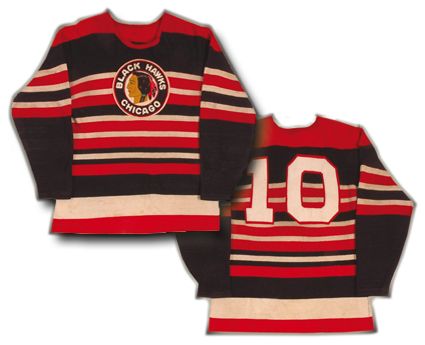
Today's first video is a look back at Mosienko's legendary record shattering hat trick.
Next, a look at the origins of the phrase "hat trick" we are certain you will find very educational.
Labels:
Chicago Blackhawks,
Mosienko Bill
Monday, March 22, 2010
1999-00 Philadelphia Flyers Craig Berube Jersey
Perhaps no other player in NHL history has introduced himself to a fan base in a more appropriate fashion than Craig Berube did on this date in 1987 when he picked up three minor penalties, two majors and a misconduct for 26 minutes in penalties, no doubt endearing himself to the Flyers faithful right from the start.

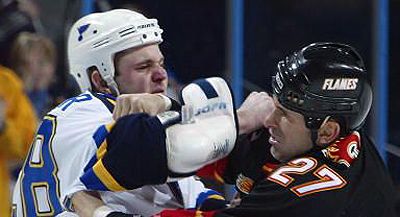
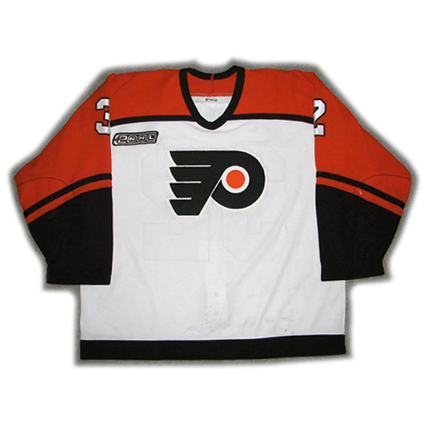
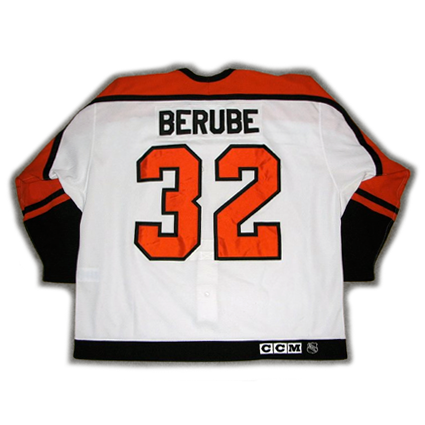
NHL2000 UNIFORM PATCH - EGGPLANT
NHL2000 UNIFORM PATCH - GREEN
NHL2000 UNIFORM PATCH - CAPITALS BLUE
Berube, an enforcer and a grinder, was signed by the Flyers as an undrafted free agent and played seven regular season games in Philadelphia in 1986-87, totaling 57 penalty minutes (PIM), and five playoff games, adding another 17 PIM to his total. He also played 63 games with the Hershey Bears of the American Hockey League (AHL), with 325 PIM, an average of over 5 PIM per game.
The next season was also split between Philadelphia and Hershey, with 27 being in the NHL and 31 in the AHL. He topped 100 penalty minutes in the NHL for the first of thirteen consecutive seasons with 108.
In 1988-89 the balance of games swung even further towards the NHL, with 53 games and 199 PIM with the Flyers and just seven games in Hershey.
The 1989-90 season saw Berube move to the NHL full time with 74 games played, 291 PIM. The left winger also reached a career high with 18 points that season from 4 goals and 14 assists. The following season saw a career high in goals for Berube with eight in 74 games and 293 PIM.
Berube then began a year of change, as the Flyers traded him to the Edmonton Oilers in May, who then dealt him to the Toronto Maple Leafs in September. After three months and 40 games, Berube was once more on his way, this time to the Calgary Flames just after the first of the year. He played a full season with the Flames in 1992-93, with over 200 PIM but was then traded once again, this time to the Washington Capitals.
Playing his role to perfection with 305 penalty minutes in 1992-93, Berube found a home in Washington, where he would play six seasons, highlighted by a run to the Stanley Cup Finals in 1998, in which he played in 21 playoff games, including scoring the first playoff goal of his career.
After six seasons with the Capitals, Berube was sold to the Flyers late in the 1998-99 season.

After a full season in Philadelphia the following year, he returned to Washington as a free agent for 2000-01 only to be traded to the New York Islanders in January.
After finishing the season with the Islanders, Berube returned to Calgary as a free agent for 2001-02 and would play the final two NHL seasons of his career with the Flames, the 14th and 15th seasons of his career with 100 penalty minutes or higher. He would receive his 3,000th penalty minute during his first season back in Calgary and the first game of the 2002-03 season with Calgary was Berube's 1,000th NHL game.

He would finish his NHL career with 1054 games, 61 goals and 98 assists for 159 points and 3,149 penalty minutes, which is good for seventh all-time in the NHL. It's a shame he couldn't finish his career in Philadelphia, as he was born to be a Flyer.
Today's featured jersey is a 1999-00 Philadelphia Flyers Craig Berube jersey from his second stint in Philadelphia, which features the NHL 2000 patch, worn on all players jerseys that season.
The NHL 2000 patch comes in a variety of colors related to the team colors of each individual club. The majority of them were black or one of several shades of blue, but there were also red, eggplant, green and maroon, which we will detail below.


We wonder if we will be able to find any videos of Berube on YouTube.com set to music by Metallica?
Seems like a longshot, but let's find out...
Hell, yea! What violence and mayhem! Old time hockey! It makes me want to get started on a mullet right now.
In this next video, Berube lives out every fan's dream and pops the linesman right square in the face, cutting him open.
Dasherboard:
Here is the list of NHL 2000 patches, their colors and the teams that
wore them that we complied back when they were first available.
NHL 2000 Patch color history
Note: Home Jerseys were white and road jerseys were dark that season.
NHL2000 UNIFORM PATCH - BLACK
Worn by the Bruins, Sabres, Kings, Flyers, Coyotes Home and Away, Penguins, Sharks, Lightning, Flames Alt, Blackhawks Alt, Capitals Alt
NHL2000 UNIFORM PATCH - BRIGHT RED
Worn by the Flames Home and Away, Hurricanes, Red Wings, Panthers Home and Away, Devils, Senators and World All-Star
NHL2000 UNIFORM PATCH - NAVY BLUE
Worn by the Oilers, Predators, Islanders, Canucks, Thrashers Home, Panthers Alt, Rangers Alt and North American All-Star
NHL2000 UNIFORM PATCH - EGGPLANT
Worn only by the Mighty Ducks of Anaheim
NHL2000 UNIFORM PATCH - DARK RED
Worn by the Canadiens and Blackhawks
NHL2000 UNIFORM PATCH - GREEN
Worn by the Stars and Coyotes Alt
NHL2000 UNIFORM PATCH - CAPITALS BLUE
Worn only by the Capitals Home and Away
NHL2000 UNIFORM PATCH - MAROON
Worn by the Avalanche, Thrashers Road
NHL2000 UNIFORM PATCH - MEDIUM BLUE
Worn only by the Maple Leafs
NHL2000 UNIFORM PATCH - ROYAL BLUE
Worn by the Blues and Rangers Home and Away
This
information was found online during the time the patches were in use.
Based on our personal experience, there is a difference between the Navy
Blue and the Royal Blue, but the shade of "Medium Blue" apparently worn
by the Maple Leafs is quite difficult to distinguish from the Royal
Blue, if there even is a difference.
Also, we question the existence of two different shades of red. NHLPatches.info lists only eight colors and not the ten we have here, eliminating the Medium Blue and second shade of red.
For visual representations of these patches in use, we recommend the essential NHLUniforms.com.
Just click on the 1999-00 link on the right hand column to see the all
the styles of jerseys the various clubs were wearing that season.
Labels:
Berube Craig,
Philadelphia Flyers
Subscribe to:
Comments (Atom)

